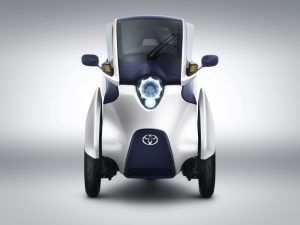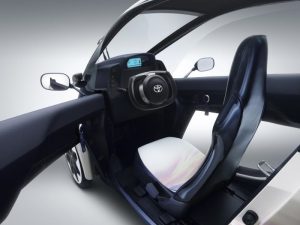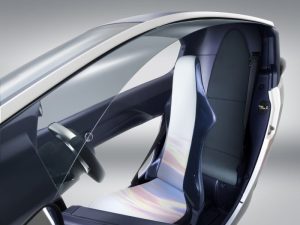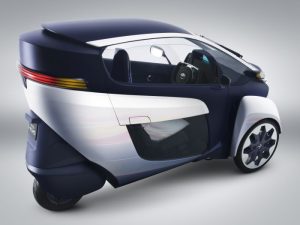KEY POINTS
- Toyota i-ROAD, a new form of transport, making its debut at Geneva
- Compact, all-electric, three-wheeled personal mobility vehicle (PMV) with a comfortable, enclosed two-seater cabin
- New Toyota ‘Active Lean’ technology automatically balances the vehicle when cornering or travelling over stepped surfaces
- 850mm width is no greater than a conventional two-wheeler, making i-ROAD as easy to manoeuvre as a scooter or motorcycle through urban traffic.
- Zero emissions, near-silent EV powertrain gives a range of up to 30 miles, with recharging from a conventional power supply taking just three hours
Toyota’s new i-ROAD personal mobility vehicle (PMV) makes its world debut at the Geneva motor show, a new, flexible form of transport designed for city streets.
Seating two in tandem and under cover, i-ROAD is an electric vehicle with a range of up to 30 miles (50km) on a single charge. Using ‘Active Lean’ technology, it is safe, intuitive and enjoyable to drive, with no need for driver or passenger to wear a helmet.
It’s the latest concept to emerge from Toyota’s 40 years of research and development of vehicles that use less energy, place less of a burden on the environment and are practical in meeting people’s everyday transport needs. i-ROAD takes the company closer to its goal of creating the ultimate range of eco cars.
Toyota i-Road technical specifications (Tokyo and Toyota City test model)
| Overall length (mm) | 2,345 |
| Overall width (mm) | 870 |
| Overall height (mm) | 1,455 |
| Wheelbase (mm) | 1,695 |
| Kerb weight (kg) | 300 |
| Tyre size – front | 80/90R16 |
| Tyre size – rear | 120/90R10 |
| Min. turning radius (m) | 3.0 |
| Powertrain | 2 electric motors |
| Max. speed (mph) | 37 |
| Cruising range on single charge (miles) | 30 (at steady 18.6mph) |
| Battery type | Lithium-ion |
TOYOTA i-ROAD HITS THE STREETS IN FIRST PUBLIC TRIALS
24/03/2014 – Toyota has launched the first public trials of its ultra-compact i-Road electric three-wheeled “personal mobility vehicle” to find out how it shapes up in the cut-and-thrust of real-world urban driving. Consumer testing in Tokyo is set to run from today (24 March) through to early June, with 10 of the single-seater vehicles taking to the city streets. The 20 people involved in the programme range from industry experts through to members of the general public, so that Toyota can gain a wide range of feedback on what i-Road is like to drive, how easy it is to use around town, how it affects people’s decisions about what journeys to make and driver satisfaction.
The vehicles are based on the concept versions shown at last year’s Tokyo motor show, but with adjustments to improve visibility, ease of use and manoeuvrability. Its compact, slim shape and 300kg kerb weight make i-Road as nimble to handle in traffic as a scooter, but with car-like stability thanks to its two-at-the-front-one-at-the-rear wheel configuration and a clever, Toyota-engineered leaning attitude when cornering.
More research into i-Road’s potential as a valuable addition to community-based transport networks is under way in Toyota City, where it has recently been introduced into the experimental Ha:mo low carbon urban transport project. It is also coming to Europe this year with two-seater models set to take part in a vehicle sharing programme that will operate in the French city of Grenoble over the next four years.
i-Road joins “Ha:mo” urban transport system in Toyota City
Toyota has announced the introduction of the i-Road personal mobility concept to the “Ha:mo” urban transport system trials. The concept, which made its world debut at 2012 Geneva motor show, will be used alongside existing Toyota COMS personal mobility vehicles from early 2014.
“Ha:mo” is an urban transport system designed to combine all forms of public and private transport with the aim of improving traffic flow and minimising emissions. The system uses electric vehicle car sharing and traffic routing information to ensure the most appropriate form of transportation is used by travellers.
The introduction of Toyota’s i-Road concept is just one action in the expansion of the “Ha:mo” system:
1. Increase in size of electric vehicle fleet
- Number of COMS electric vehicles increased from 10 to 100 in October. All COMS vehicles will be fitted with keyless operation.
- Number of Yamaha PAS power-assisted bicycles increased from 10 to 100 in October.
2. Introduction of “Ha:mo” smartphone application
- The new “Ha:mo” application will have a range of features including:
- Suggestion of new route options based upon traffic flow and local vehicle station stocking levels
- Reservation of vehicles
- Access to local bus timetables
- ‘Push’ notifications of predicted traffic congestion and weekly traffic congestion forecasts that encourage the use of different roads and transportation methods
3. Increase in number of vehicle stations
- Users will be able to rent and return vehicles at 17 new locations from October, an increase from the four currently in operation. These stations will be conveniently located near main train stations and major public facilities.
4. Trials of Fee-based Sharing Service
- From October 1, a fee system will be introduced to the commercial feasibility of the sharing service. Fees will start at 200 yen (around £1.30) for the first 10 minutes and 20 yen (around £0.13) per minute thereafter.
5. Increase in number of Ha:mo members
- “Ha:mo” membership is projected to rise from 100 to 1,000 in October, improving the level of data being received from the tria
Toyota is paving the way for several types of eco car to co-exist in the future, by adapting its Hybrid Synergy Drive technology for use in plug-in hybrid electric vehicles (PHEVs), electric vehicles (EVs) and fuel cell vehicles (FCVs). While hybrids, plug-in hybrids and FCVs are ideal for mainstream use over medium to long distances, Toyota believes in the feasibility of EVs to serve as a main mode of transport for short urban journeys, and has 10 years’ experience in the research and development of PMVs.
People using this kind of vehicle want something that is more comfortable, offers better weather protection and is safer than a two-wheeler such as a scooter or motorcycle, but has similar benefits of low running costs, easy parking and around-town manoeuvrability.
The ultra-compact, three-wheel i-ROAD measures 2,350mm long and 1,445mm high and has a 1,700mm wheelbase. It’s most significant dimension, though, is its width: at only 850mm, it is no wider than a conventional two-wheeler. Not only does this make for easy manoeuvring through congested traffic, it also means four can be parked in a single parking bay.
The zero-emissions, all-electric powertrain uses a lithium-ion battery to power two 2kW motors mounted in the front wheels, giving brisk acceleration and near-silent running. Driving range is around 30 miles, after which the battery can be fully recharged from a conventional domestic power supply in three hours.
Toyota’s new and entirely intuitive Active Lean technology is the key to i-ROAD’s high levels of stability, safety, comfort and fun-to-drive character. The system uses a lean actuator and gearing mounted above the front suspension member, linked via a yoke to the left and right front wheels. An ECU calculates the required degree of lean based on steering angle, gyro-sensor and vehicle speed information, with the system automatically moving the wheels up and down in opposite directions, applying lean angle to counteract the centrifugal force of cornering.
The system also operates when the PMV is being driven in a straight line over stepped surfaces, the actuator automatically compensating for changes in the road to keep the body level. The minimum turning circle is just three metres.
No special skills are needed to pilot i-ROAD; the Active Lean system offers a unique driving experience with the enjoyment of riding a two-wheeler, but with no need for the driver to stabilise the vehicle when manoeuvring at low speed, or when stationary.
As the driver doesn’t have to put his or her feet on the road surface at any time, i-ROAD can be fitted with a safer, weatherproof, closed body and so can be driven without wearing a helmet. This design also allows for a more car-like environment on board, with the potential for features such as lighting, heating, audio and Bluetooth to be provided.
Toyota envisages its i-ROAD concept has the potential to play a significant role in reducing urban traffic congestion and air pollution. Commuters can use public transport or conventional private vehicles to travel to urban perimeter transportation hubs where they will transfer to the Toyota i-ROAD to complete their journeys into the city centre.
The new Toyota PMV’s compact size, manoeuvrability, easy parking, rapid charging and choice of an open or closed cabin make it an ideal urban vehicle, designed to reduce congestion and CO2, NOx and particulate emissions without compromising individual freedom of mobility.






